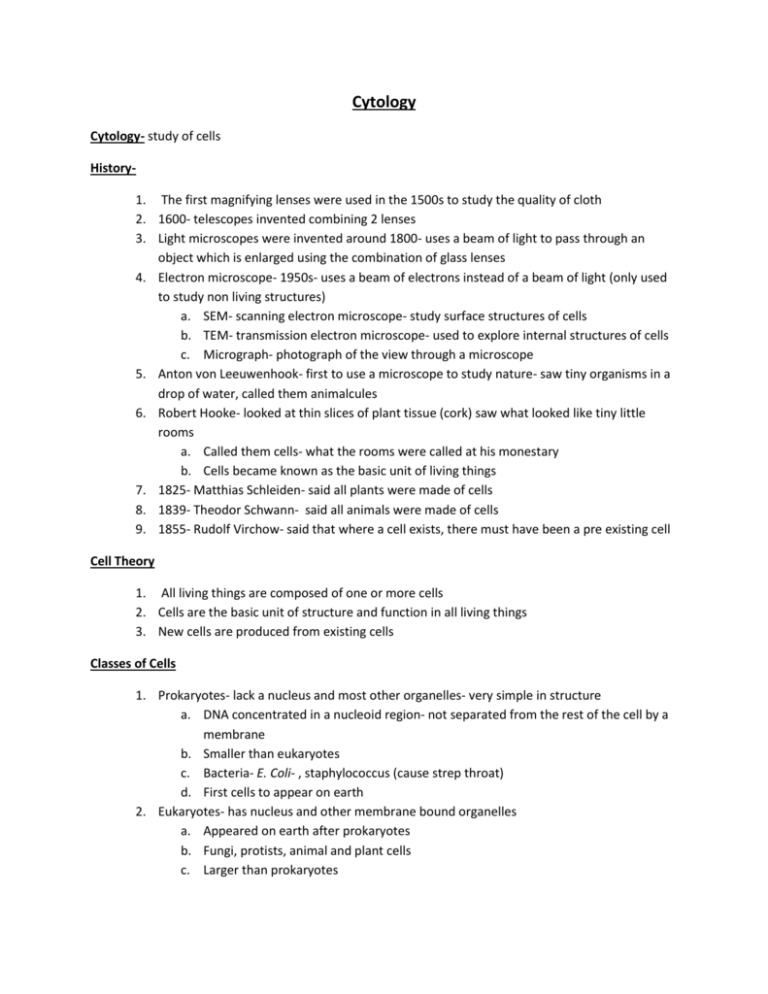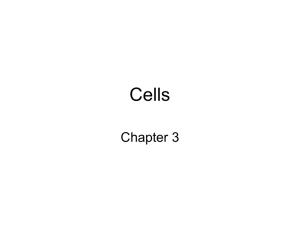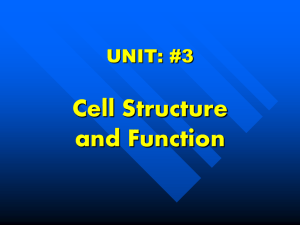Cytology Notes
advertisement

Cytology Cytology- study of cells History1. The first magnifying lenses were used in the 1500s to study the quality of cloth 2. 1600- telescopes invented combining 2 lenses 3. Light microscopes were invented around 1800- uses a beam of light to pass through an object which is enlarged using the combination of glass lenses 4. Electron microscope- 1950s- uses a beam of electrons instead of a beam of light (only used to study non living structures) a. SEM- scanning electron microscope- study surface structures of cells b. TEM- transmission electron microscope- used to explore internal structures of cells c. Micrograph- photograph of the view through a microscope 5. Anton von Leeuwenhook- first to use a microscope to study nature- saw tiny organisms in a drop of water, called them animalcules 6. Robert Hooke- looked at thin slices of plant tissue (cork) saw what looked like tiny little rooms a. Called them cells- what the rooms were called at his monestary b. Cells became known as the basic unit of living things 7. 1825- Matthias Schleiden- said all plants were made of cells 8. 1839- Theodor Schwann- said all animals were made of cells 9. 1855- Rudolf Virchow- said that where a cell exists, there must have been a pre existing cell Cell Theory 1. All living things are composed of one or more cells 2. Cells are the basic unit of structure and function in all living things 3. New cells are produced from existing cells Classes of Cells 1. Prokaryotes- lack a nucleus and most other organelles- very simple in structure a. DNA concentrated in a nucleoid region- not separated from the rest of the cell by a membrane b. Smaller than eukaryotes c. Bacteria- E. Coli- , staphylococcus (cause strep throat) d. First cells to appear on earth 2. Eukaryotes- has nucleus and other membrane bound organelles a. Appeared on earth after prokaryotes b. Fungi, protists, animal and plant cells c. Larger than prokaryotes Cellular Diversity 1. Unicellular Organisms- single celled, made of one cell a. Do everything to be considered living b. Prokaryotic- bacteria c. Eukaryotic- algae, yeasts d. Colonial organisms- live in groups and have few specialized structures 2. Multicellular Organisms a. Cell specialization- cells specialized to perform particular functions within an organism i. Pancreatic cells- produce protein enzymes to help digest food ii. Liver cell- remove toxins from blood b. Level of organization i. Atom ii. Cell iii. Tissue- groups of similar cells with a common function Epithelial, connective, nervous, muscle iv. Organ- many groups of tissues working together (each muscle has connective and nervous tissue) v. Organ system- group of organs working together (muscular, nervous, digestive, etc.) vi. organism Cell Structures 1. Organelle- part of a cell that has a specific job to do 2. Plasma membrane (cell membrane)- thin outer covering of the cell- tiny organ a. Regulates the transport of substances across boundaries and maintains a specific chemical environment within the cell (homeostasis) i. Selectively permeable- regulates what enters and leaves the cell- allows certain substances to enter, stops others b. Contains phospholipids and proteins i. Phospholipids- made of a hydrophobic (water fearing) tail, and a hydrophilic (water loving) head, tail is pushed away from water, head is attracted to it ii. Phospholipid bilayer- two layer of phospholipids with tails toward the center and the heads toward the outside or inside of the cell or organelle- useful because cells are bathed in an acqueous solution, and the cytoplasm is an acqueous solution c. Membrane proteins- attached to the cell membrane and moves through freely i. Used for transport of materials across the membrane- transport proteins 3. 4. 5. 6. ii. Help cells communicate with each other- can pick up chemical signals from other cells iii. Integral proteins- extend across entire membrane iv. Peripheral proteins- on the inside or outside surface of membrane Nucleus- contains the cell’s DNA which controls the cell’s activity a. Chromatin- DNA attached to long fibers of protein in the nucleus, fills nucleus b. DNA holds instructions for making protein in the cell c. Where RNA is copied from DNA d. Nuclear envelope- surrounds the nucleus i. Contains nuclear pores- small holes where materials can exit the nucleus (RNA leaves and travels to the ribosome to make proteins) e. Nucleolus- small, dense region in nucleus, where ribosomes are produces from RNA f. Chromosomes- formed by chromatin when the cell divides i. Contain genetic information passed from one generation to the next ii. Formed when chromatin condenses into smaller, threadlike structures Cytoplasm- entire region between the cell membrane and the nucleus, organelles suspended within fluid a. Most of the organelles contain their own membrane that separates them from the cytoplasm b. Cytoplasm made mostly of water, also contains solutes Cell Wall- found in plants, fungi, algae and some prokaryotes a. Not found in animal cells b. Allow water, oxygen, CO2 to pass through c. Main function is to provide support and protection d. Contains long chains of cellulose (complex carbohydrate) e. Primary cell wall- develops just as cell is being formed outside of the cell membrane i. As cell expands- cellulose and other molecules are added enlarging the cell wall ii. Grows with the cell f. Secondary cell wall- added when the cell is at full sizebetween the primary cell wall and the cell membrane i. Tough and woody structure ii. Once completed, the cell can grow no further g. Pectin- gluey substance that holds plant cells together i. Forms middle lamella- layer of pectin between cells Ribosomes- made of RNA and proteins that were made in the nucleolus a. Most numerous organelle in the cell b. Protein assembly line- site of protein synthesis c. Some attached to membranes (endoplasmic reticulum)- make proteins that are exported out of the cell or that become part of the cell membrane d. Some suspended in the cytoplasm- make proteins that are used by the cell e. Produce proteins based on instructions from the nucleus 7. Endoplasmic Reticulum- (ER)- network of membranes in the cell, used as main manufacturing and transportation a. Produces many types of molecules b. Intracellular highway- path in which molecules move from one part of the cell to another c. Rough ER- has ribosomes attached to the surface, involved in protein synthesis i. Proteins move from ribosome into RER to be modified and exported from the cell ii. Will package proteins into vesicles to be exported iii. Cells that secrete a lot of protein are rich in RER- cells of salivary glandssecrete enzymes into your mouth to begin digestion d. Smooth ER- no ribosomes attached to surface i. Perform specialized functions in cell- breakdown of toxic substances in liver cells, production of lipids in ovaries and testes 8. Golgi Apparatus- modifies, routes and stores proteins and other molecules to their next destination a. Series of flattened sacs b. Refine and modify ER products by altering their chemical structure and are then moved in vesicles to other locations c. Products from ER move here through vesicles, will be modified or altered and then transported to their next destination by vesicles d. Products can go to other spots in the cells or be exported from the cell 9. Lysosome- contain digestive enzymes that can break down many molecules a. Fuse with food and expose nutrients to enzymes- help nourish cells b. Destroy harmful bacteria that may enter cell c. Break down old organelles that are no longer useful 10. Vacuoles- store undigested nutrients a. Contractile vacuole- found in some single celled freshwater organisms- pumps out excess water that may diffuse into the cell b. Plant cells- large, central vacuole filled with fluid i. Water pressure makes it possible for plants to support fruits, flowers, may occupy up to 90% of the cell ii. May contain poisons or pigments to protect the plant or give color to plants (flowers) c. Vesicle- smaller vacuole found in plants, helps to transport materials throughout the cell 11. Chloroplast- found in plant and algae cells- site of photosynthesis (converting the suns energy into chemical energy) a. Contains the green pigment chlorophyll (gives plant green color)- elp planst absorb light 12. Mitochondria- powerhouse of the cel- where cells release energy from stored food in a process called cellular respiration a. ATP- adenosine triphosphate- energy molecule produced during cellular respiration b. Found in all types of eukaryotic cells 13. Cytoskeleton- network of fibers extending throughout the cytoplasm, does not provide a rigid structure but s always changing a. Microtubules- hollow tubes of protein- give shape, rigidity and organization to the cell i. Provide tracks that other organelles can move throughout the cell (lysosome moving to food molecule) b. Microfilaments- thin solid rods of protein, allows cell to move or change shape when subunits slide past one another 14. Flagella- long, thin whip like structure a. Enable some cells to move 15. Cilia- shorter and more numerous than flagella, have a back and forth movement that moves the cell a. Both can extend from tissues in multi cellular organisms- cilia line windpipe that sweep mucus away from lungs Plant vs. Animal Cells Plant Cells 1. 2. 3. 4. 5. 6. 7. 8. Cell wall and cell membrane No cholesterol Chloroplast Leucoplasts and chromoplasts No lysosome Large vacuole No centrioles Middle lamella Animal Cells 1. 2. 3. 4. 5. 6. 7. 8. Cell membrane only Cholesterol in cell membrane No chloroplast No leucoplasts or chromoplasts Lysosome Vesicle Centrioles- involved in cell division Desmosome- hold animal cells together









